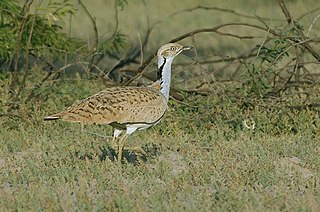
The houbara bustard, also known as African houbara, is a large bustard native to North Africa and southwestern Asia, where it lives in arid habitats. The global population is listed as Vulnerable on the IUCN Red List since 2014. The European population is restricted to the Canary Islands and has been assessed as Near Threatened in 2015.

MacQueen's bustard is a large bird in the bustard family. It is native to the desert and steppe regions of Asia, east from the Sinai Peninsula extending across Kazakhstan east to Mongolia. In the 19th century, vagrants were found as far west of their range as Great Britain. Populations have decreased by 20 to 50% between 1984 and 2004 mainly due to hunting and changes in land-use. MacQueen's bustard is a partial latitudinal migrant while the houbara bustard is more sedentary. Both species are the only members of the genus Chlamydotis. MacQueen's bustard used to be regarded as a subspecies of the houbara bustard and known as the "Asian houbara".
Beauprea congesta is a species of plant in the family Proteaceae. It is endemic to New Caledonia.
Beauprea crassifolia is a species of plant in the family Proteaceae. It is endemic to New Caledonia.
Helicia albiflora is a species of plant in the family Proteaceae. It is endemic to Papua New Guinea. It is threatened by habitat loss.
Helicia insularis is a species of plant in the family Proteaceae. It is endemic to Papua New Guinea. It is threatened by habitat loss.
Helicia peltata is a species of plant in the family Proteaceae. It is endemic to Papua New Guinea. It is threatened by habitat loss.
Leucadendron nobile is a species of plant in the family Proteaceae. It is endemic to South Africa.
Oxanthera aurantium is a species of plant in the family Rutaceae. It is endemic to New Caledonia.
Oxanthera is a genus of flowering plants in the citrus family, Rutaceae. They are endemic to New Caledonia. They are known commonly as false oranges.
Oxanthera brevipes is a species of plant in the family Rutaceae. It is endemic to New Caledonia.
Oxanthera fragrans is a species of plant in the family Rutaceae. It is endemic to New Caledonia.
Oxanthera neocaledonica is a species of plant in the family Rutaceae. It is endemic to New Caledonia.
Roupala loxensis is a species of plant in the family Proteaceae. It is endemic to Ecuador.
Stenocarpus dumbeensis was a species of plant in the family Proteaceae. It was endemic to New Caledonia.
Stenocarpus villosus is a species of plant in the family Proteaceae. It is endemic to New Caledonia. It is threatened by habitat loss.

The undulate ray is a species of ray and cartilaginous fish found in the Mediterranean and East Atlantic from southern Ireland and England to the Gulf of Guinea. It is found in areas with mud or sand, and may occur as deep as 200 m (660 ft), though it prefers shallower depths. It is considered endangered due to overfishing.

The leopard whipray is a little-known species of stingray in the family Dasyatidae, found in the Indian and Pacific Oceans from South Africa to Australia. It is found close to shore at depths shallower than 70 m (230 ft), over soft substrates. Attaining a width of 1.8 m (5.9 ft), this species has a diamond-shaped pectoral fin disc with a pointed snout and an extremely long, whip-like tail without fin folds. Adult rays have a leopard-like dorsal pattern of dark brown rings on a yellowish brown background, as well as a row of enlarged, heart-shaped dermal denticles along the midline of the disc. Newborns and small juveniles have large, solid dark spots and few denticles. The leopard whipray is caught by fisheries in many parts of its range, primarily for meat.

The honeycomb whipray is a species of stingray in the family Dasyatidae, found widely in the shallow coastal waters of the Indo-Pacific from India to the Malay Archipelago. This large species grows to 1.3 m (4.3 ft) across and has a diamond-shaped disc with rounded corners and a projecting, pointed snout. Its tail is long and whip-like, without fin folds. Adults have a striking dorsal color pattern consisting of large, dark brown rings and reticulations delineated by thin yellow lines, while juveniles have a pattern of large dark spots. This ray can also be distinguished from its similar relatives by an enlarged, pearl-like dermal denticle at the center of the back, which is followed by a few thorns. The International Union for Conservation of Nature (IUCN) has assessed the honeycomb whipray as endangered, as it faces heavy fishing pressure and habitat degradation across much of its range.





